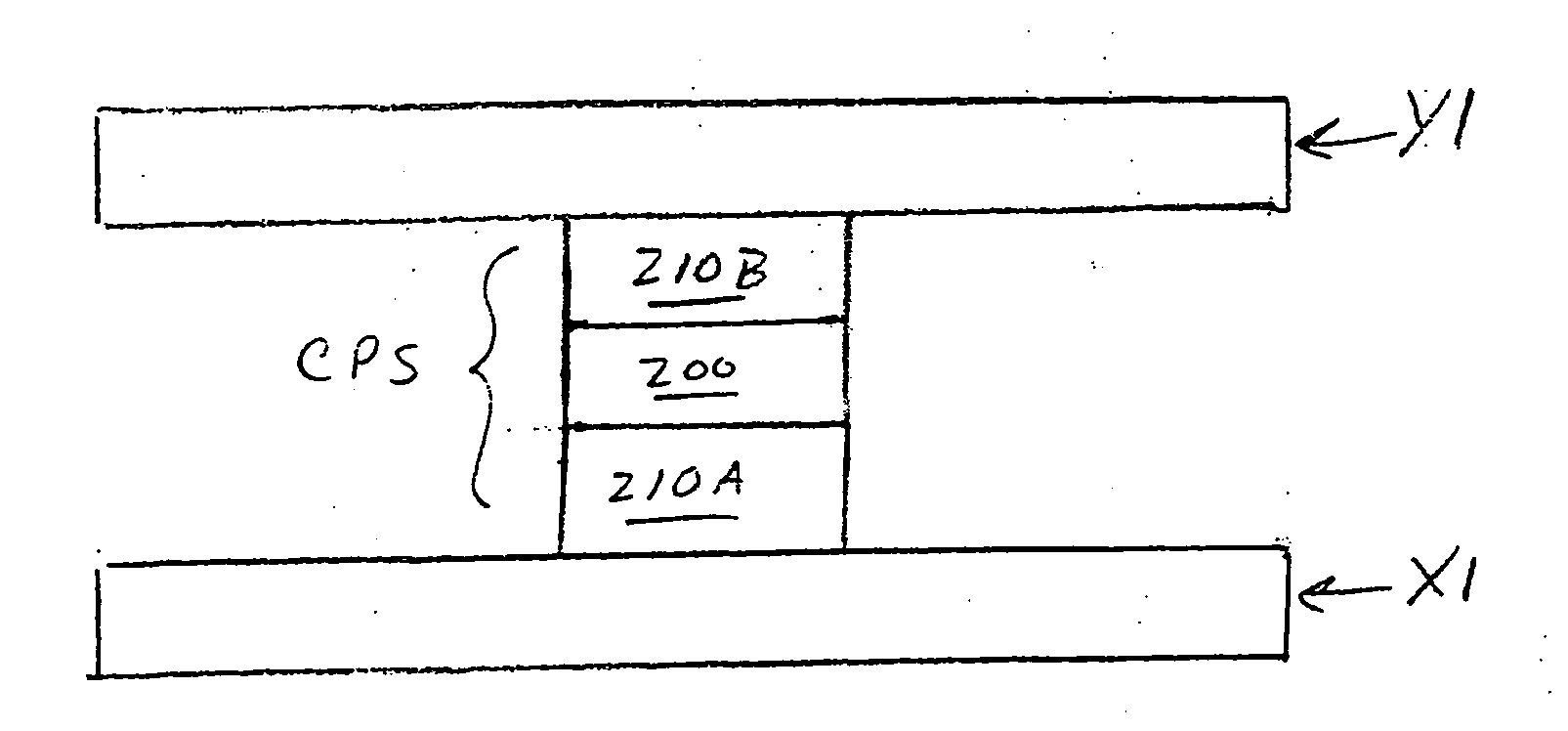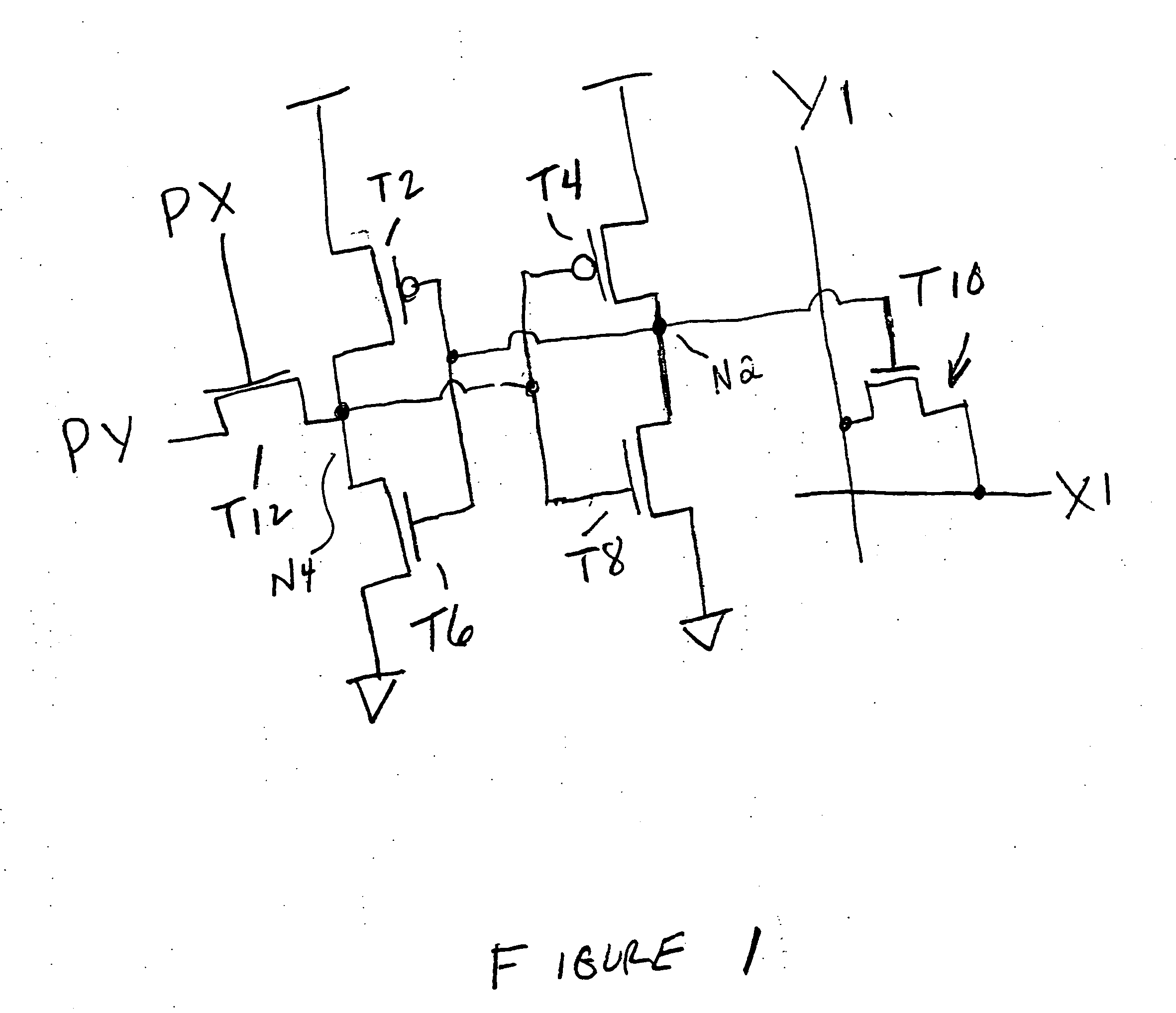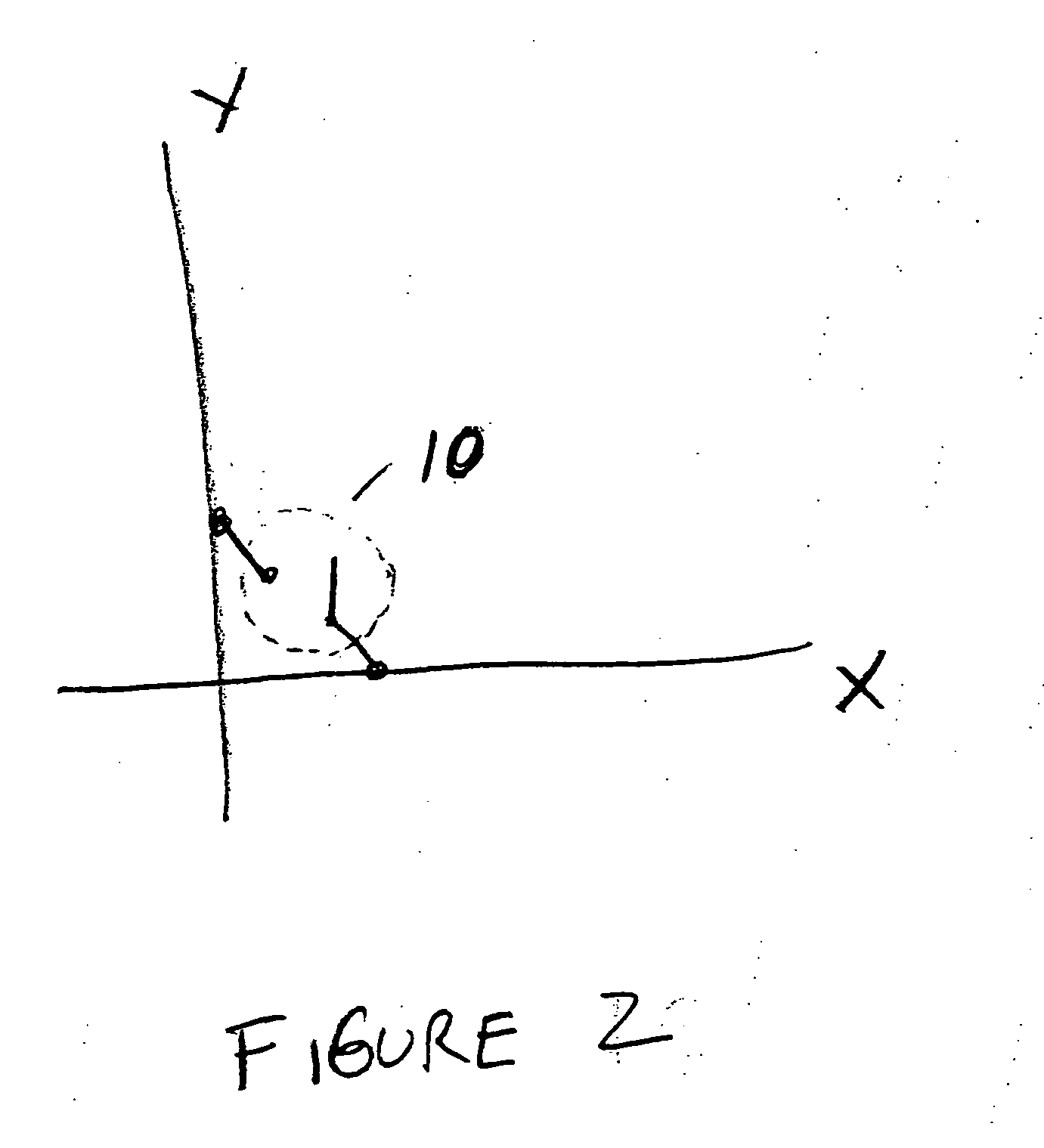Programmable matrix array with phase-change material
Active Publication Date: 2006-05-11
OVONYX MEMORY TECH LLC
View PDF8 Cites 49 Cited by
- Summary
- Abstract
- Description
- Claims
- Application Information
AI Technical Summary
Benefits of technology
[0032] One aspect of the present invention is a programmable connection comprising a programmable resistance material such as a phase-change material. Such a thin-film programmable connection may be located and fabricated between the intersection of the lines to be coupled by programming. Such a programmable connection may be programmed by the lines to be coupled, without additional programming lines located at or connected to the programmable connection. Instead, the programming control lines and programming devices may be located anywhere along the interconnect lines, and, for example, more conveniently and efficiently on the ends of the interconnectable lines. Thus the programming devices and lines are shared across more than one programmable connection to reduce programming overhead area for improved efficiency and cost.
[0033] The low resistance or set state of the phase-change material may be used where a CLOSED connection or short is desired between the layers of interconnect. The high resistance or reset state may be used where an OPEN connection is desired between the layers. Leakage through OPEN connections may be reduced by lowering the power supply relative to the threshold voltage Vth of the phase change material, or by raising Vth relative to the normal operating range of the power supply.
[0036] In sections of the design where lower resistance is desired at a cross-point, such as to drive the heavy capacitance load of a driver device input, several X-Y lines may be wired in parallel. Alternately, a small buffer gate may be permanently wired-in to drive the higher capacitance input. Permanently wired interconnects may also be used for other logic connections in order to reduce the number of programmable connections, thereby further reducing leakage as well as test requirements. Alternately, an SRAM programmable connection (or one or more other existing alternatives) may be wired in parallel with or used on the same chip with the phase-change programmable connections disclosed herein.
[0037] The breakdown layer may have an adequately high resistance so that no significant increase in leakage or battery drain occurs for those programmable connections having a breakdown layer that is not selected and penetrated.
[0038] Advantageously, the programmable connection may be made as a thin-film phase-change material and located between the interconnect conductive layers, preferably reducing chip size and / or freeing up more underlying chip area for logic while still being reversible for improved testability and field repair / changes. The thin-film programmable connection may comprise a phase-change material as well as a breakdown layer separating the material from one of the conductive layers. The breakdown layer is penetrated in those programmable connections which are actually programmed to a low resistance or tested to assure field programmability. With testability as described herein, a limitation against use of a thin-film programmable connection for larger logic arrays is overcome.
Problems solved by technology
This approach is characterized by good layout efficiency and performance, but higher tooling costs and time delay to first article product since custom masks and layout are used for each different customer product.
The power drained off by the cross-points intended to be OPEN is a larger problem in larger logic arrays with more X-Y interconnects, and hence more cross-points.
Upon power-on restart, the logic interconnect pattern may be reloaded into the logic gates, at the expense of delayed restart.
This full mux approach provides lower resistance but at the expense of greater capacitance and increased chip area for each matrix switch.
However, such an approach increases process complexity.
Further, both the SRAM or the non-volatile alternative require considerable area in the base silicon to implement the switch, since the cross-point transistor alone may take up considerable area that could otherwise be dedicated to logic and interconnect.
Extra interconnect similarly may require extra chip area or interconnect layers that may raise cost and complexity of the delivered product.
Once programmed to a lower resistance state, an anti-fuse cannot be readily reversed.
Accordingly, testing in the field may be difficult and reversing a programmed anti-fuse may not be possible.
Manufacturers of equipment may find an error in FPLA operation after programming at the factory and shipment to the customer that could be fixed if the programming is reversible, perhaps allowing correction through remote dial-up and download to re-program the logic if the cross-point programming is reversible.
However, while such an option is possible with SRAM or its non-volatile equivalent, such an option may not be possible with a fuse-based or anti-fuse based approach.
Instead, the part may instead be removed and replaced at considerable expense to the manufacturer and inconvenience to the customer.
Further, due to the testing limitations of using irreversible links, testing of the arrays intended for use by the customer may be done only indirectly by programming spare but representative anti-fuses on a fuse or anti-fuse based interconnect approach before a part is shipped.
However, actual programming of (untested) links used by the customer may be unsuccessful, since the links or cross-points actually used may be defective since they are untested before being shipped or used. programmable connections found unprogrammable may require return of the unit to the factory or even replacement in the final equipment if personalization is done after assembly.
Each of these discards may be at successively higher cost and require an undesirable manufacturing and field use flow which is incompatible with a more preferred zero-defect manufacturing and use.
Further, the non-SRAM based approaches may add processing steps, beyond those of making the logic to be interconnected, that excessively raise cost.
Method used
the structure of the environmentally friendly knitted fabric provided by the present invention; figure 2 Flow chart of the yarn wrapping machine for environmentally friendly knitted fabrics and storage devices; image 3 Is the parameter map of the yarn covering machine
View moreImage
Smart Image Click on the blue labels to locate them in the text.
Smart ImageViewing Examples
Examples
Experimental program
Comparison scheme
Effect test
case 1
ogrammable connection comprises a phase-change material:
->it is labeled as CPS
case 2
ogrammable connection comprises a phase-change material but does not include a breakdown layer:
->it is labeled as WCPS
case 3
ogrammable connection comprises a phase-change material and a breakdown layer:
->it is labeled as BCPS
the structure of the environmentally friendly knitted fabric provided by the present invention; figure 2 Flow chart of the yarn wrapping machine for environmentally friendly knitted fabrics and storage devices; image 3 Is the parameter map of the yarn covering machine
Login to View More PUM
 Login to View More
Login to View More Abstract
A phase-change material is proposed for coupling interconnect lines an electrically programmable matrix array. Leakage may be reduced by optionally placing a thin insulating breakdown layer between the phase change material and at least one of the lines. The matrix array may be used in a programmable logic device. The logic portions of the programmable logic device may be tri-stated.
Description
RELATED APPLICATION INFORMATION [0001] This application is a continuation-in-part of U.S. patent application Ser. No. 10 / 983,491 filed on Nov. 8, 2004. U.S. patent application Ser. No. 10 / 983,491 is hereby incorporated by reference herein.FIELD OF THE INVENTION [0002] The present invention generally relates to programmable integrated circuit devices, and more particularly to a programmable matrix array with programmable connections made with phase-change materials. BACKGROUND OF THE INVENTION [0003] Generally, phase-change materials are capable of being electrically programmed between a first structural state where the material is generally amorphous and a second structural state where the material is generally crystalline. The term “amorphous”, as used herein, refers to a structural condition which is relatively less ordered or more disordered than a single crystal. The term “crystalline”, as used herein, refers to a structural condition which is relatively more ordered than amorph...
Claims
the structure of the environmentally friendly knitted fabric provided by the present invention; figure 2 Flow chart of the yarn wrapping machine for environmentally friendly knitted fabrics and storage devices; image 3 Is the parameter map of the yarn covering machine
Login to View More Application Information
Patent Timeline
 Login to View More
Login to View More IPC IPC(8): H01L29/00
CPCG11C13/0004G11C2213/77H03K19/177H01L45/06H01L45/12H01L45/1233H01L45/144H01L27/2463Y10S438/90H03K19/17736H10B63/80H10N70/801H10N70/231H10N70/826H10N70/8828
Inventor PARKINSON, WARD
Owner OVONYX MEMORY TECH LLC
Features
- R&D
- Intellectual Property
- Life Sciences
- Materials
- Tech Scout
Why Patsnap Eureka
- Unparalleled Data Quality
- Higher Quality Content
- 60% Fewer Hallucinations
Social media
Patsnap Eureka Blog
Learn More Browse by: Latest US Patents, China's latest patents, Technical Efficacy Thesaurus, Application Domain, Technology Topic, Popular Technical Reports.
© 2025 PatSnap. All rights reserved.Legal|Privacy policy|Modern Slavery Act Transparency Statement|Sitemap|About US| Contact US: help@patsnap.com



